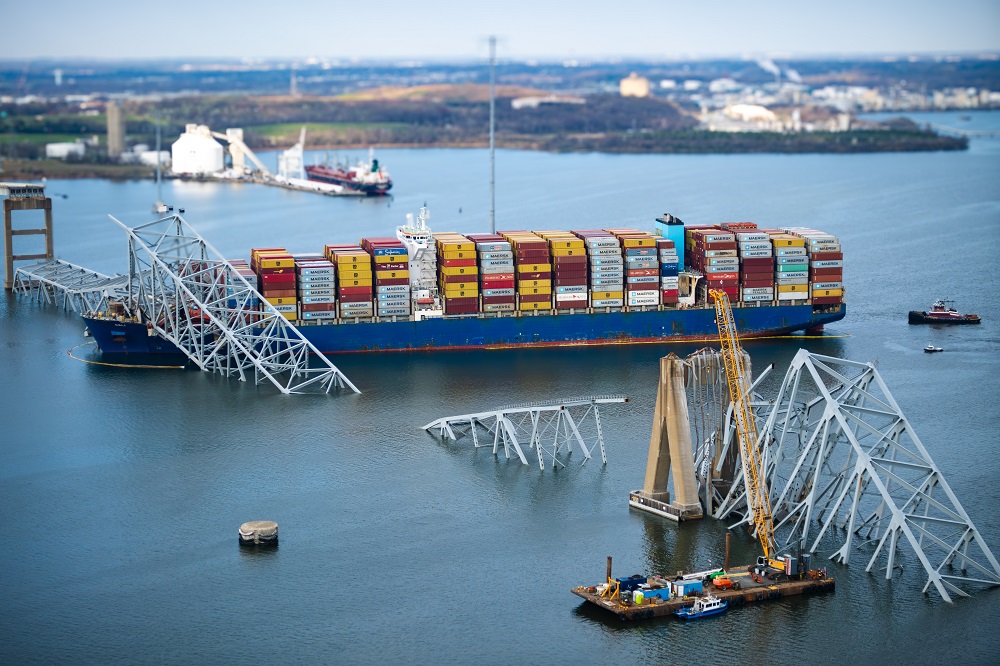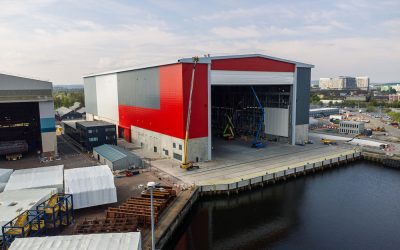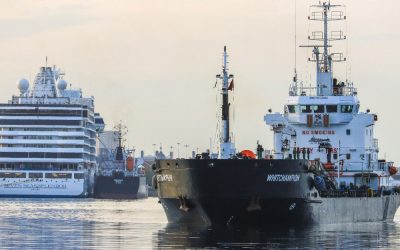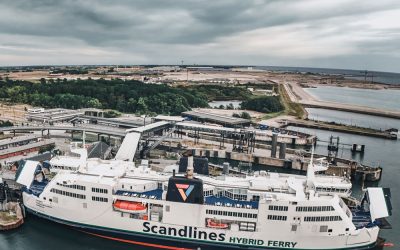Learning from this tragedy could prove an invaluable lesson in risk mitigation with complex maritime operations, writes John Butler
In the early morning of 26th March the container ship Dali struck the Francis Scott Key Bridge in Baltimore forcing its dramatic collapse which was captured and circulated on television and social media across the world. This is a textbook example of a Black Swan Event, an unexpected incident that has disproportionately created a social and economic impact on a local area. This incident also shines a light on the offshore industry, maritime insurance, and the importance of Marine Warranty Surveyors.
The collapse of the Francis Scott Key Bridge in Maryland has not only had significant implications for the local community but has also raised important concerns for maritime shipping operations. As a major artery for maritime traffic, the collapse of the bridge has disrupted supply chains, impacted shipping schedules, and raised concerns about insurance coverage for the companies involved both in maritime shipping and infrastructure.
The collapse of the bridge also draws questions about liability. In the case of a bridge collapse, determining liability will be a complex process involving multiple parties. Unpicking how and where the liability lies will be assessed and reviewed through the investigation process.
Nevertheless, this incident raises some immediate questions, for example:
- What preventative measures were put in place to mitigate potential incidents?
- Has modernisation of the global shipping fleet increased risk of damage to critical infrastructure such as bridges?
- Is there an increased role for marine warranty to support risk mitigation for insurers?
This incident also highlights the necessity of hull and machinery insurance for maritime vessels. Such insurance provides coverage for physical damage to a vessel and its equipment, including damage resulting from collisions, grounding, and other accidents. With a bridge collapse potentially posing a hazard to vessels navigating the waterway, insurers will need to assess the risks to insured vessels and determine the coverage available under their policies.
Vessel owners may need to take additional precautions when ensuring the safety of their ships and crew.
Another area of concern is the risk to vessels and their insurers when operating in waters where there is poor design of infrastructure. It could be argued that had the Francis Scott Key Bridge had adequate fendering, the third party liability claim would be far less.
The main protection in the case of the Francis Scott Key Bridge are structures known as ‘dolphins’, these circular concrete structures are located near the bridge’s main supports. Any vessels that drift off course are expected to collide with these structures and avoid impact of the bridge. The design of these dolphins has not significantly changed since the 1970’s when the bridge was first build.
Over the same period the size and frequency of vessels visiting Baltimore has significantly increased. This naturally elicits questions concerning the suitability of aged infrastructure, such as the Francis Scott Key Bridge, and how these structures are designed to mitigate vessel impacts. What effect could this have on other bridges and how should the risk of older infrastructure be addressed?
All of this leads to protection and indemnity. Following a major incident protection and indemnity insurance, also known as P&I insurance provides protection for shipping operations. This is a form of mutual maritime insurance provided by a P&I club which covers for a wide range of liabilities, including third-party bodily injury, property damage, pollution, and wreck removal.
In the event of a maritime incident resulting from a bridge collapse, P&I clubs may need to respond to claims from injured parties, property owners, or environmental regulators. Insurers will need to work closely with their policyholders to manage these liabilities and ensure appropriate coverage is in place. So, with all these liabilities and insured risks, how do underwriters protect themselves, considering they may never see the ships they underwrite?
This is where the “Marine Warranty Surveyor” (MWS) is responsible.
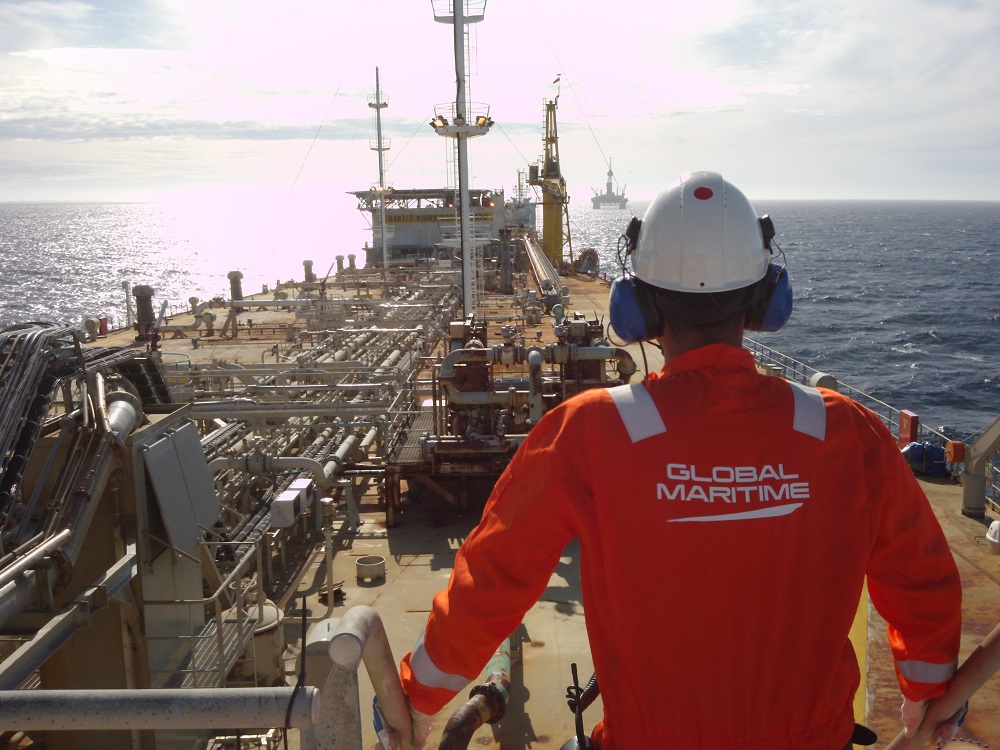
Source: Global Maritime
What is a Marine Warranty Surveyor?
Insurance underwriters require an MWS as a part of the insurance policy. The insured party engages a competent organisation to review and approve planned operations on behalf of the insurer. The MWS is ultimately a risk mitigation. This is performed through review of design calculations, and procedures to perform specific tasks. This verifies all work is performed to the accepted standards and that it presents no undue risk, other than that normally expected to the insurance underwriter.
Depending on the purpose there are different types of marine warranty policies, these include Marine Machinery, Project Cargo, General Cargo, or Construction All Risk, (CAR). Surveyors are not always required; however, this does not mean that they are not always needed.
Independent third parties such as MWS can play a greater role by reviewing maintenance records on behalf of P&I clubs. Thereby safeguarding other interested stakeholders that are generally not covered by Class Societies. This would create an additional layer of protection to ensure that adequate reviews are undertaken for the management and transportation of cargo.
In general terms for Marine policies, i.e. hull and machinery, there is not a requirement to have an MWS present. Cargo policies which include large assets such as drydocks, and MODUs will have some allowance for MWS. CAR polices usually have the largest engagement with Marine Warranty Surveyors where the potential cost of equipment or project delays is substantial.
So, considering the collapse of the Francis Scott Key Bridge, it is clear, now is the time to review our engagement with Marine Warranty Surveyors and ensure that we are adequately de-risking the impacts on vessels, infrastructure, and the local economy. By increasing engagement between vessel owners, operators, and insurance underwriters there is the potential to both save costs and increase safety performance.
These events have a broader implication for the maritime shipping industry. Supply chain disruptions, increased transportation costs, and delays in cargo delivery could impact the bottom line for shipping companies and their insurers. Insurers and policyholders will need to work together to navigate these challenges and ensure that appropriate coverage is in place to mitigate the financial risks. As an industry we also must be cognizant of the rapidly changing shipping sector in comparison to aged infrastructure. Port studies need to recognise that there is an increasing risk to their infrastructure and adequate mitigations need to be put in place to protect their systems.
Understanding risks
Overall, the collapse of the Francis Scott Key Bridge has significant insurance implications for maritime shipping operations. Insurers will need to carefully assess the risks and coverage available under various policies, while shipping companies will need to take steps to protect their vessels, cargo, and personnel in the wake of this tragic event.
More focus needs to be placed on mitigation of risk and how the industry can leverage the knowledge of the MWS community to drive safety and reduce exposure. By working together, insurers and policyholders can address the challenges posed by the bridge collapse and help the maritime shipping industry recover from this disruption. Infrastructure exposure is another key risk that has been highlighted through the impact of maritime shipping. This is something that needs to be addressed and accounted in marine operations.
As the investigations into the cause of the collapse continues, insurance adjusters will play a key role in helping to navigate the complex insurance landscape in the aftermath of this tragedy. By understanding and mitigating risks associated with complex marine operations it will be possible to learn the lessons from this tragedy and ensure that these are brought forward for future operations.
If you want to find out more about the role of Insurance Underwriters, Loss Adjustors and Marine Warranty Surveying please do not hesitate to get in contact.

John Butler, Global Maritime
John Butler CEng FIMarEST is an Marine Engineer with over 25 years’ experience in maritime, oil and gas and now energy transition industries. A Chartered Mechanical Engineer and a Fellow of the IMarEST. John now holds the role of Global Lead – Energy Transformation at Global Maritime. Where he is responsible for the Strategy and Development of new and existing business streams within the marine sector.
For more information visit: www.globalmaritime.com
